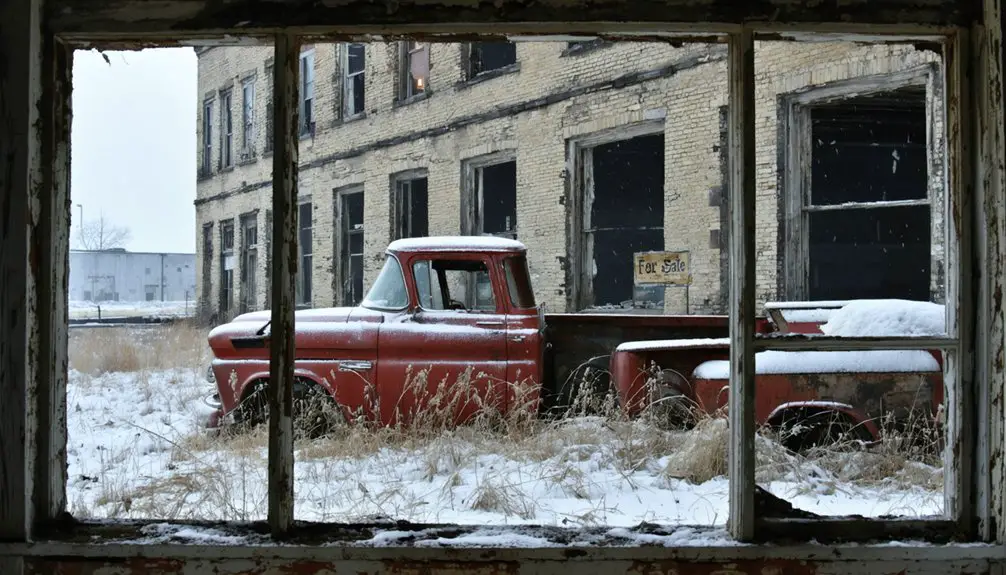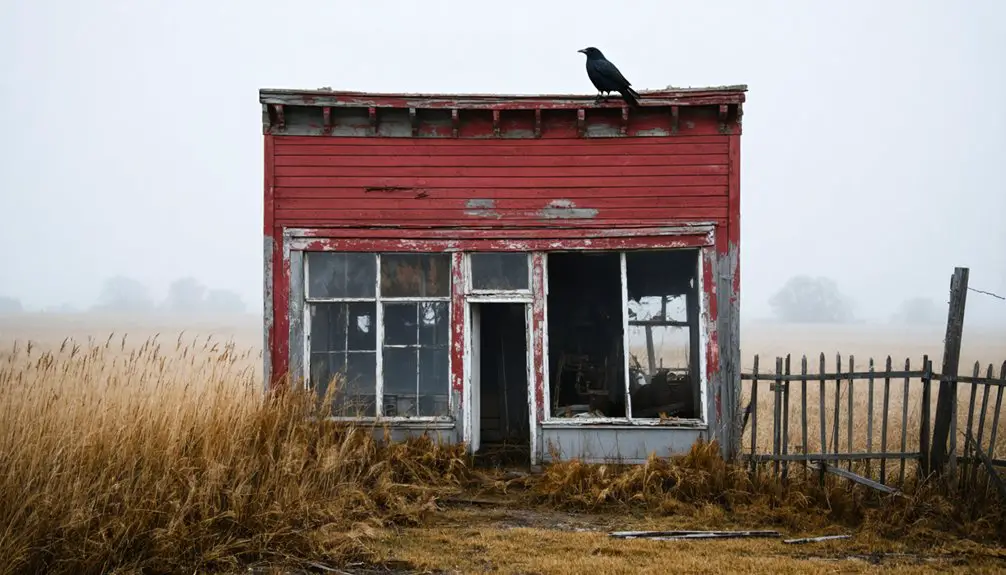You’ll find San Francisco, Minnesota’s ghost town along the Minnesota River near Carver Rapids, where William Foster established it in 1854. The settlement initially thrived with stores, warehouses, and a school, but losing its county seat status to Chaska in 1856 triggered its decline. A devastating flood in 1863, combined with challenging terrain and poor soil conditions, sealed its fate. The site’s history reveals fascinating lessons about frontier settlement vulnerabilities.
Key Takeaways
- San Francisco, Minnesota became a ghost town after losing its county seat status to Chaska in 1856, triggering economic decline.
- Founded by Donner Party survivor William Foster in 1854, the town was strategically located along the Minnesota River.
- A devastating flood in 1863 destroyed vital infrastructure and accelerated the town’s abandonment.
- Natural challenges, including poor soil drainage and dangerous river rapids, made the location ultimately unsuitable for settlement.
- The ghost town’s history serves as a cautionary tale about environmental impacts on settlement viability in early Minnesota.
From Promising Settlement to Ghost Town
Though San Francisco began as a promising settlement and the original county seat of Carver County in the 1850s, its fate took a dramatic turn when it lost this prestigious position to Chaska in 1856.
The town was established by William Foster in 1854, marking the beginning of its brief but notable existence. Despite significant settlement challenges, the town initially showed remarkable community resilience, establishing the area’s first store, warehouse, and school. A ferry service in 1859 further demonstrated the settlers’ determination to build connections. This decline was similar to what the California San Francisco experienced during the Panic of 1873, though with far different ultimate outcomes.
However, losing the county seat dealt a devastating blow to the town’s economic foundation, eliminating a primary reason for visitors and new settlers. The decline in administrative importance, combined with the persistent flooding of its swampy river valley location, ultimately led to the community’s abandonment by 1864-1865.
William Foster’s Vision and Early Development
Behind San Francisco’s rise and fall stands William Foster, a remarkable figure who survived the tragic Donner Party expedition before settling in Minnesota.
Foster’s ambition led him to purchase land along the Minnesota River near Carver Rapids in 1854, naming his settlement after the California city he’d left behind.
In 1854, Foster carved his California dreams into Minnesota’s wilderness, buying riverside land and christening it after San Francisco.
Much like the town of Station Island, which would later become Drawbridge, San Francisco, Minnesota started as a modest settlement with big aspirations.
You’ll find Foster’s strategic vision in his early infrastructure projects. He quickly established the town’s first store and warehouse, positioning them to serve steamboat passengers forced to transfer at the rapids.
He divided the land into lots for settlers, opened a post office by 1856, and supported the first school with teacher Levi Williams.
The Impact of County Seat Relocation
When San Francisco lost its status as Carver County seat to Chaska in 1856, you’d have witnessed an immediate power shift that stripped the fledgling town of its administrative and judicial functions.
The loss triggered rapid economic decline as government officials, legal professionals, and business travelers redirected their activities to Chaska.
Without the steady stream of county-related commerce, San Francisco’s merchants and service providers couldn’t sustain their operations, leading many to abandon their enterprises and relocate to more prosperous settlements.
The town’s struggles intensified when severe flooding in 1863 caused devastating damage to the remaining structures.
Political Power Shift
As San Francisco relinquished its status as Carver County’s seat to Chaska in 1856, a dramatic shift in political power reshaped the region’s governance landscape.
You’ll find that this transfer fundamentally altered the dynamics of local governance, concentrating administrative authority and decision-making power in Chaska’s growing community.
The move wasn’t just about relocating offices – it transformed political engagement throughout the county.
A catastrophic 1863 flood devastated San Francisco’s downtown area, further cementing its diminished role in county affairs.
Chaska’s new position as the administrative hub drew government resources, infrastructure investment, and civic participation away from San Francisco.
The shift created new political alliances and leadership networks centered in Chaska, while San Francisco’s influence waned.
Those seeking to participate in county affairs now had to pivot their attention to Chaska, which became the undisputed center of regional political activity.
Economic Ripple Effects
Following the loss of its county seat status, San Francisco experienced devastating economic aftershocks that rippled through every sector of its local economy.
The economic dislocation led to widespread business closures, with retail shops and hospitality services shuttering their doors as consumer spending plummeted. You’d have witnessed the rapid decline in property values and mounting job losses, forcing many residents to seek opportunities elsewhere. The once-bustling shopping district now requires security at every store. This decline mirrors historical patterns where white flight and suburban sprawl led to abandoned urban centers.
The town’s community resilience was tested as tax revenues dried up, creating a downward spiral of reduced public services and infrastructure decay.
Surrounding towns absorbed much of San Francisco’s displaced economic activity, permanently altering regional commerce patterns. The exodus of younger workers and families left behind an aging population, while vacant properties and declining investment opportunities transformed this once-vibrant county seat into a shadow of its former self.
Natural Forces Shape the Town’s Destiny
Despite initial settler optimism, the harsh natural forces around San Francisco’s location proved insurmountable for the town’s survival.
You’ll find that nature dealt the settlement a double blow: the treacherous Carver Rapids created a natural barrier to steamboat navigation, while the swampy terrain left the town vulnerable to devastating floods.
The town’s environmental resilience was constantly tested as the Minnesota River Valley’s challenging landscape shaped its destiny.
You can trace how the 1863 flood destroyed essential infrastructure, including the warehouse, while persistent flooding deterred rebuilding efforts.
The town’s position below the rapids, combined with poor soil drainage, made farming nearly impossible and maintenance costs unbearable.
These environmental challenges ultimately forced settlers to abandon their dreams, and the land returned to its natural state.
Economic Challenges and Population Decline

While San Francisco initially showed promise as Carver County’s first seat in 1854, the town’s economic fortunes took a sharp downturn when officials relocated the county seat to Chaska in 1856.
You’d have witnessed a rapid economic stagnation as government activities and visitors dwindled, followed by devastating floods in 1863 that destroyed the town’s crucial infrastructure.
William Foster’s investments in the warehouse, store, and hotel couldn’t overcome the harsh realities of limited river navigation and frequent flooding.
The settlement abandonment accelerated as residents followed opportunities elsewhere, finding the town’s dependence on transient river traffic unsustainable.
The town’s challenges mirrored those faced by early Minnesota settlements that couldn’t sustain themselves through fur trading alone.
Legacy of a Lost Minnesota River Settlement
The short-lived town of San Francisco stands as a testimony to the precarious nature of early Minnesota River settlements.
You’ll find in its story a powerful example of community resilience against environmental challenges and shifting political fortunes.
While the settlement ultimately failed, its cultural heritage lives on through the documented experiences of its founder William Foster, a Donner Party survivor who brought his western dreams to Minnesota’s riverbanks.
- Foster’s innovative use of the Carver Rapids’ limitations created temporary economic opportunities
- The town’s brief tenure as county seat shows the fluid nature of frontier political power
- Early infrastructure investments demonstrated pioneer-era community planning
- The settlement’s demise highlights the decisive role of environmental factors in frontier town survival
These historical lessons continue to resonate with modern riverside communities facing similar challenges of sustainability and adaptation.
Frequently Asked Questions
What Happened to William Foster After the Town’s Abandonment?
You’ll find William Foster’s later life remains largely undocumented, though records show he left to “get his affairs in order” after the 1863 flood devastated his town-building legacy.
Were There Any Indigenous Settlements at the Exact Town Site Before?
Yes, you’ll find clear evidence of Dakota settlements – specifically Sisseton and Wahpeton bands maintained a large village right by the rapids where the town later stood, following traditional indigenous settlement patterns along waterways.
How Many People Lived in San Francisco During Its Peak Population?
Hold onto your hat – you’re looking at a peak population of 888 people back in 2000. Despite earlier population growth and historical significance, you’ve never seen more than 1,000 folks living there.
Did Any Original Buildings From San Francisco Survive to Modern Times?
You won’t find any surviving structures from the original town today. Historical preservation wasn’t possible since flooding in the 1860s destroyed the buildings, and the remaining ones were removed as farmland took over.
What Was the Average Land Price for Lots During Initial Sales?
You can’t pinpoint the exact initial land value, as records haven’t survived. Based on similar town development patterns of the era, lots likely sold between $25-100 during early sales.
References
- https://en.wikipedia.org/wiki/San_Francisco
- https://www.carvercountyhistoricalsociety.org/ghost_towns.php
- https://racketmn.com/san-francisco-is-in-minnesota
- https://www.fws.gov/story/ghost-town-carver-rapids
- https://www3.mnhs.org/mnopedia/search/index/place/ghost-towns-carver-county
- https://www.tptoriginals.org/what-about-those-ghost-towns-of-carver-county/
- https://www.cbsnews.com/sanfrancisco/news/kpix-5-tours-drawbridge-bay-areas-only-ghost-town/
- https://storage.googleapis.com/mnhs-org-support/mn_history_articles/57/v57i07p330-345.pdf
- https://www3.mnhs.org/mnopedia/search/index/place/carver-county
- https://www.public.news/p/why-looting-turned-san-francisco



